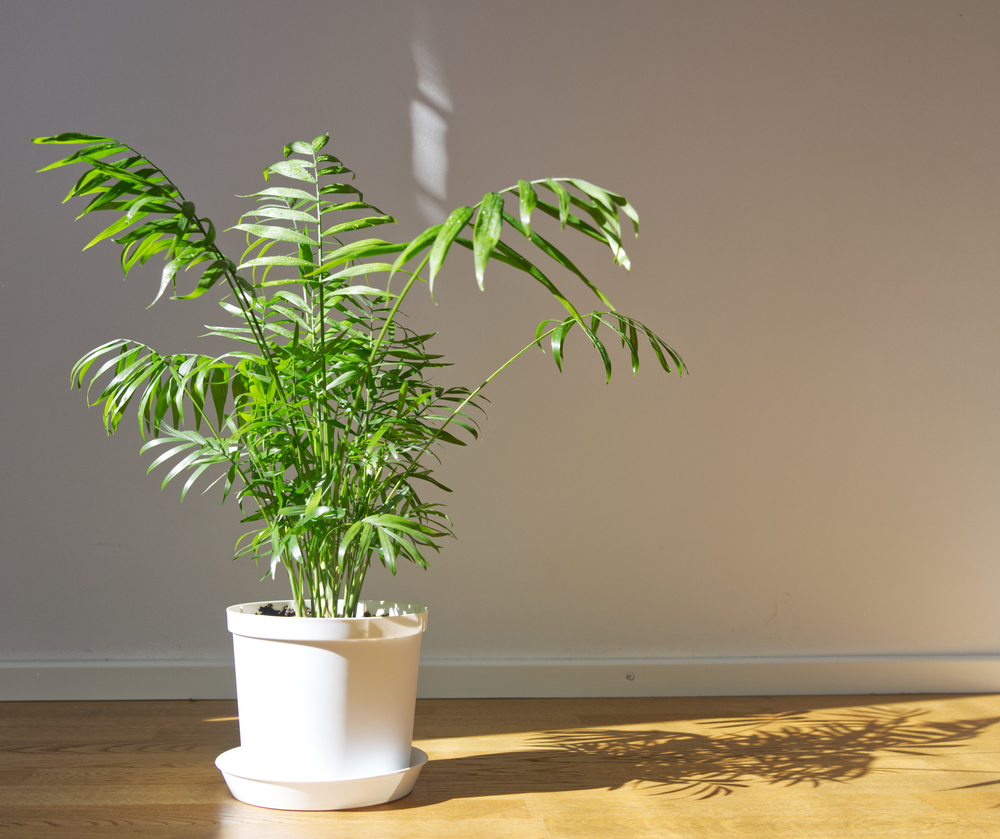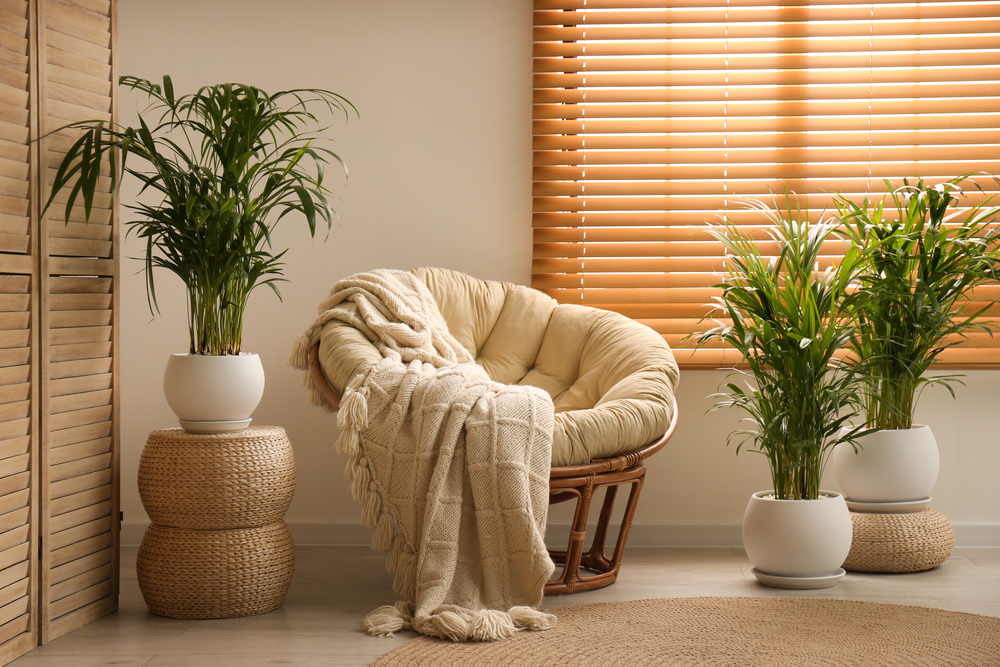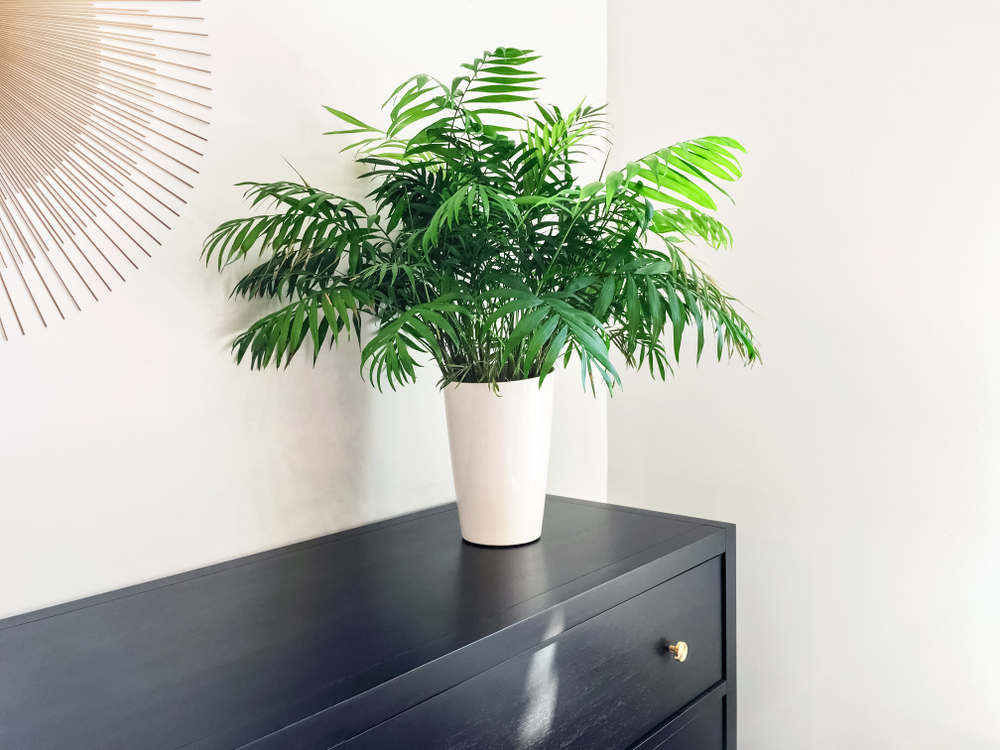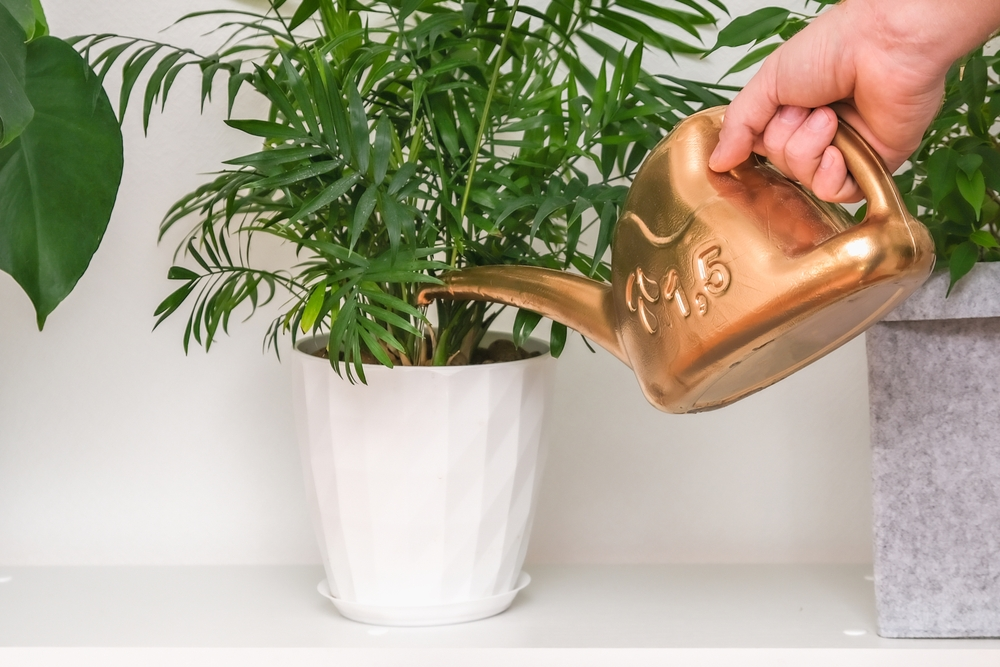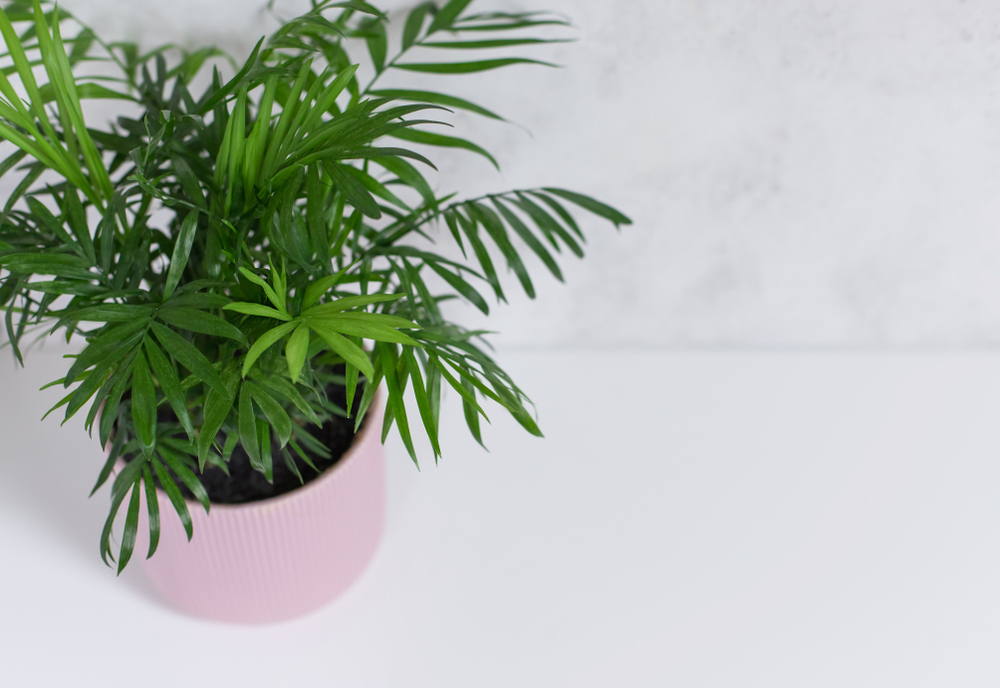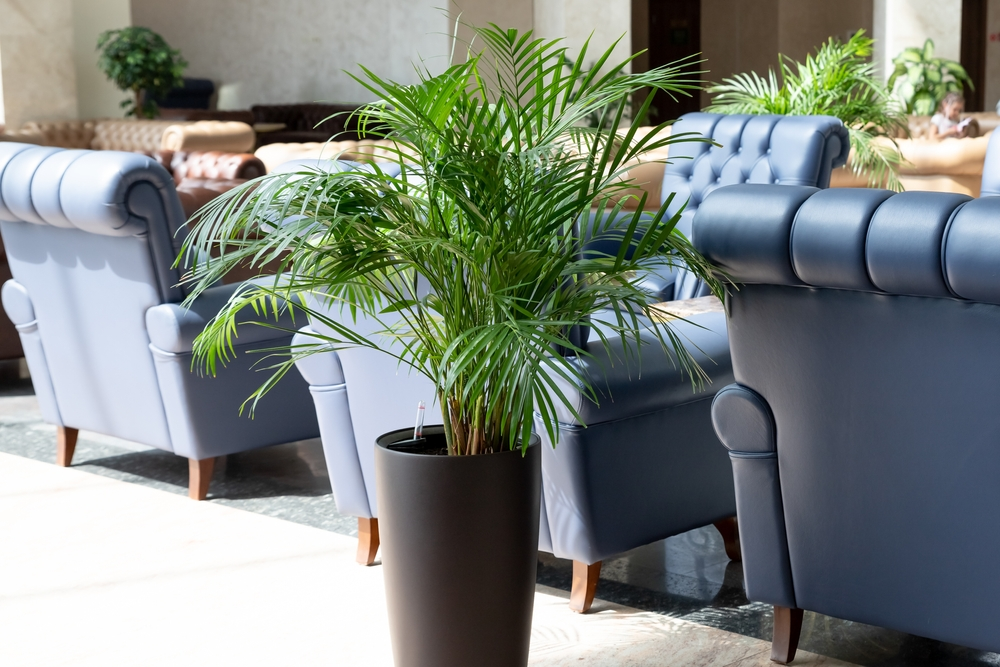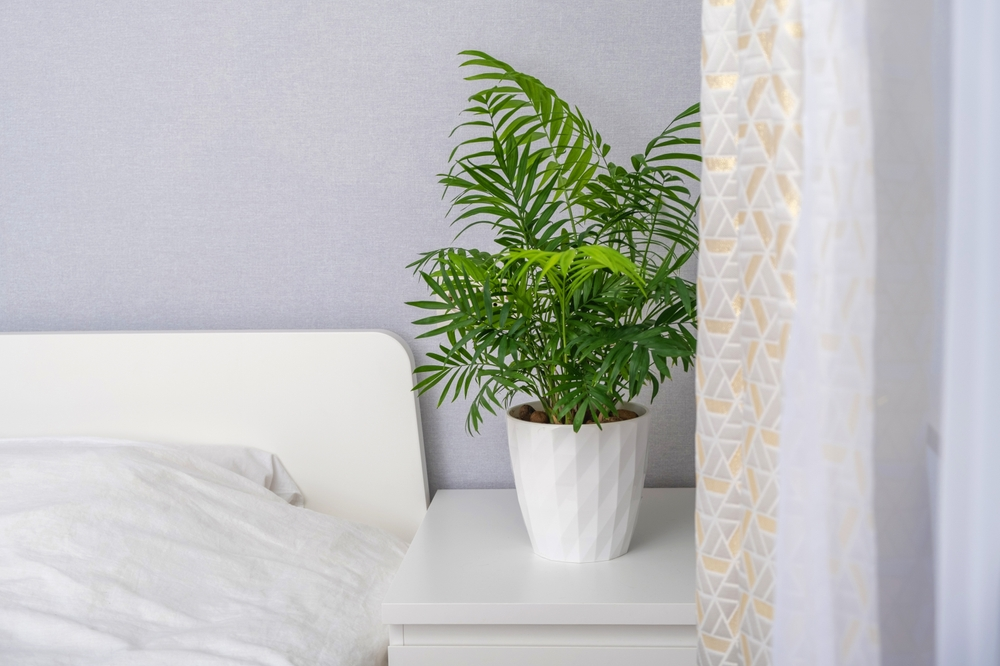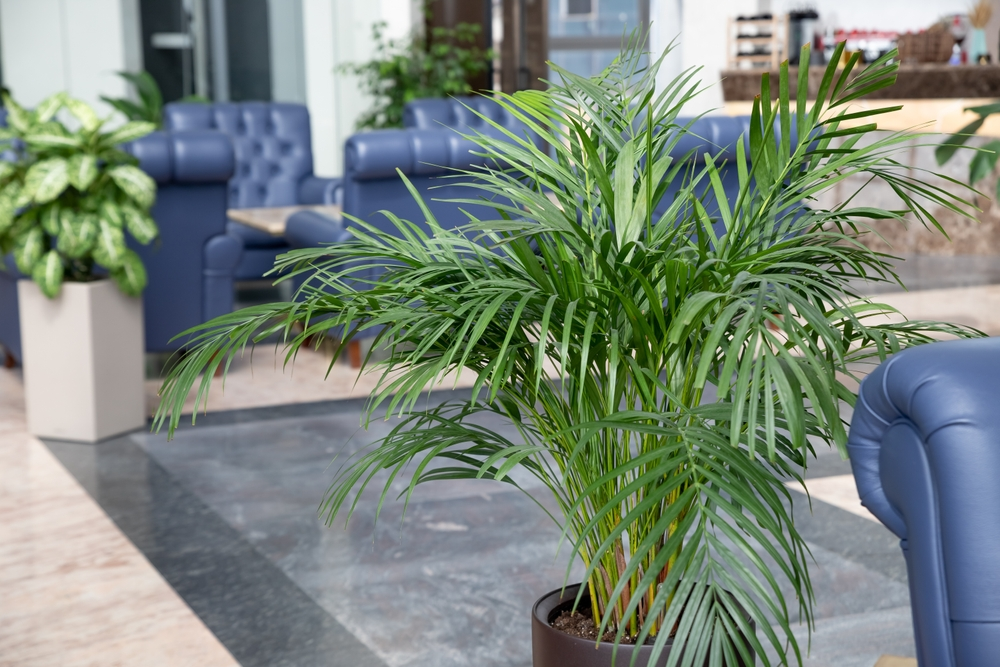HousePlantJoy is supported by our audience. When you purchase through one of our links, we may earn a small affiliate commission. As an Amazon Associate I earn from qualifying purchases. Your cost is not affected.
==================
How to Care for Your Parlor Palm Plant
Imagine bringing a touch of tropical paradise into your home or office with a parlor palm plant. Parlor palms are versatile, low-maintenance plants that instantly transform any space into a lush, green oasis. With proper care, these frilly plants keep beauty and tranquility abounding in your home.
You can discover the secrets to successfully growing and caring for these beautiful houseplants.
Short Summary
- Parlor palms, or Chamaedorea elegans, are an ideal houseplant due to their low maintenance needs and air-purifying qualities.
- Create the ideal growing conditions of bright, indirect light, humidity, and well-drained soil for a parlor palm to thrive.
- Decorate with parlor palms indoors or outdoors; they come in various sizes suitable for any space!
Understanding Parlor Palms
Parlor palms, also known as Chamaedorea elegans, have a rich history as popular houseplants since the Victorian era. Native to Southern Mexico and Central America, these elegant indoor palms are admired for their deep green, feathery foliage and adaptability to various environments.
They are easy to care for and thrive in low-light conditions, making them an excellent choice for any home or office. Parlor palms are also known for their air-purifying qualities, helping to remove toxins from the air.
Origin and History
The parlor palm’s journey began in the rainforest regions of Southern Mexico and Guatemala, where it thrived under the forest canopy. Its popularity as a houseplant can be traced back to the Victorian era when it’s lush foliage and graceful appearance symbolized elegance and status.
Known by several names, including “dwarf mountain palm,” “good luck palm,” and “near the palm,” the parlor palm has remained a favorite among indoor gardeners for its adaptability and low-maintenance requirements.
Appearance and Features
The parlor palm’s charm lies in its delicate, feathery foliage and bamboo-like stems that gracefully arch over time. The leaves are deep green and borne on arching branches, creating a tropical ambiance in any setting.
Although slow-growing, parlor palms can reach up to 3 feet tall when cultivated indoors and up to 6 feet tall in their native habitat. The parlor palm grows best outdoors when exposed to optimal conditions. It produces small, yellow flowers in the summer, followed by round black fruits with seeds inside.
Ideal Growing Conditions for Parlor Palms
To ensure your parlor palm thrives, providing the ideal growing conditions is essential. These plants require bright, indirect light, humidity, and well-drained soil to flourish. Overwatering and pruning should be avoided, as it can lead to root rot and other issues.
By understanding the parlor palm’s natural habitat and preferences, you can create a comfortable environment for your plant to grow strong and healthy.
Light Requirements
Parlor palms prefer bright, indirect light to maintain their lush foliage. While they can tolerate some direct sunlight, excessive exposure can cause the leaves to burn and turn yellow.
If you want to place your parlor palm outdoors during the summer, please ensure it is in a shaded area with dappled light to protect the plant from harsh sun.
Temperature Preferences
Temperature plays a crucial role in the health of your parlor palm. The ideal temperature range for these plants is between 65°F and 80°F. Exposure to cold drafts can result in dry leaf margins or brown tips, so keeping your parlor palm away from drafty windows or doors is essential.
If outdoor temperatures fall below the suitable range, consider transferring your salon palm indoors to a location with similar lighting conditions until the weather warms up.
Humidity Needs
Humidity is another critical factor for maintaining a healthy parlor palm. These plants thrive in environments with consistent moisture levels. To increase humidity around your parlor palm, you can mist the foliage regularly or group it with other houseplants to create a microclimate with slightly higher humidity.
It’s essential to avoid placing the plant near heating vents, as these can create dry, arid conditions that can harm your parlor palm.
Planting and Propagation
Whether you’re a seasoned indoor gardener or new to houseplants, selecting a healthy parlor palm is the first step toward successful cultivation. Propagating parlor palms from seed can be challenging, so purchasing a new plant or dividing an existing one is often easier.
This section discusses the factors to consider when selecting a healthy parlor palm and the techniques for successful propagation.
Selecting a Healthy Plant
When choosing a salon palm, look for plants with dark green foliage and a perky, upright appearance. Avoid specimens with yellow or brown leaves, wilting, or signs of insects or disease.
Please ensure the pot has drainage holes, as proper drainage is essential for preventing root rot and other issues. Selecting a healthy plant sets the stage for a thriving, low-maintenance addition to your indoor garden.
Seed Propagation
While propagating parlor palms from seed is possible, it can be difficult and time-consuming. Many home growers prefer to purchase a new plant or divide an existing one.
If you decide to propagate from seed, use a soilless mix that promotes healthy root growth and provides nutrients for your parlor palm. You can successfully grow a new parlor palm from seed with patience and proper care.
Caring for Your Parlor Palm
Once you’ve selected and planted your parlor palm, providing the proper care to ensure its continued health and growth is important. This section discusses essential care tips, including watering, soil and potting mix, and fertilization.
By following these guidelines, you’ll be well on your way to maintaining a happy, thriving parlor palm.
Watering Schedule
Watering is a critical aspect of salon palm care. The amount of water your plant requires depends on the light it receives. More light necessitates more water, while less light requires less water.
To determine if your parlor palm needs watering, insert your finger in the soil; if the top few inches are dry, it’s time to water. Be sure to water around the base of the plant, and take care not to overwater, as this can lead to root rot and other issues.
Soil and Potting Mix
Choosing the suitable soil and potting mix for your parlor palm is essential for its health and growth. A well-draining, nutrient-rich potting mix allows the plant’s roots to access the necessary nutrients without becoming waterlogged.
You can use a commercial, peat-based potting mix or create your own by combining peat with perlite or sand for improved drainage. Ensuring your parlor palm has the proper soil environment will help it flourish and grow strong.
Fertilization
Fertilizing your salon palm is an essential aspect of its care. These plants have relatively low fertilizer requirements and can be fertilized with a water-soluble houseplant or tropical plant food monthly during the growing season.
In the winter, you should reduce fertilization as the plant’s growth slows. By providing the right nutrients and following a proper fertilization schedule, you can ensure that your parlor palm remains healthy and vibrant.
Pruning, Repotting, and Maintenance
A well-maintained salon palm will reward you with lush green fronds and a tropical ambiance.
This section discusses the importance of pruning, repotting, and general maintenance for keeping your parlor palm healthy and thriving.
Pruning Techniques
While parlor palms are generally low-maintenance plants, occasional pruning can help maintain their health and appearance. Focus on removing lower leaves and leaflet tips, as this can promote healthy growth.
Before pruning, sterilize your scissors or shears with rubbing alcohol to prevent the spread of disease. You don’t need extra pruning, as the plant will naturally lose old fronds.
Repotting Guidelines
I would need you to please be sure to keep your parlor palm healthy. It’s recommended to repot your plant every 2-3 years during active growth, using a well-drained, slightly acidic soil like Tanks’ Pro Organic Cactus and Succulent Mix.
When repotting, choose a pot slightly larger than the original with adequate drainage holes to prevent root rot. By repotting your parlor palm at the appropriate intervals, you can ensure it thrives and grows strong.
Cleaning Leaves
Keeping your parlor palm’s leaves clean is essential for maintaining health and appearance. To clean the leaves, spritz them with water and wipe them down with a paper towel or clean cloth. You can even place your plant under a shower for thorough cleaning if it is significant.
Please don’t use unique leaf-cleaning products, which can harm your plant. Regularly cleaning your parlor palm’s leaves will keep them looking vibrant and healthy.
Dealing with Pests and Diseases
Although parlor palms are not particularly prone to pests or diseases, watching for potential issues is essential. In this section, we’ll discuss common pests and diseases that can affect your parlor palm and offer tips for prevention and treatment.
Common Pests
Some common indoor plant pests affecting parlor palms include spider mites and scale insects. These pests can cause damage to your plant by feeding on its leaves and stems. To treat these pests, you can use safe treatments such as insecticidal soap or rubbing alcohol.
Proper care and a healthy growing environment can also help prevent pest infestations.
Disease Prevention
Diseases like root rot, cankers, and leaf spots can harm your parlor palm. Most of these diseases can be prevented through proper care and treatment. To prevent root rot, ensure your plant’s soil has adequate drainage and avoid overwatering.
Maintaining a clean growing environment and using sanitized tools for other diseases can help prevent the spread of harmful pathogens.
Decorating with Parlor Palms
Parlor palms are easy houseplants to care for and serve as beautiful decorations that can improve indoor air quality. They are versatile plants that can be grown indoors and outdoors, depending on your climate and USDA zone.
Let’s explore the different size options available for parlor palms and how they can enhance indoor and outdoor spaces.
Size Options
Small parlor palms are available in 4-inch pots, perfect for decorating workstations or shelves. Medium-sized parlor palms in 6-7 inch pots can create a visual statement on side tables and entryways. In contrast, large parlor palms are available in eight-inch or more significant pots for a dramatic effect.
With various size options, salon palms can be incorporated into any space, adding a touch of tropical elegance and improving indoor air quality.
Indoor and Outdoor Use
Parlor palms can be the perfect addition if you bring a tropical vibe to your living room or create a lush outdoor oasis. Please ensure your parlor palm receives bright, indirect light and adequate humidity for indoor use.
If you live in USDA zones 10b to 11, parlor palms can be grown outdoors, providing a stunning focal point in your garden or patio. By understanding the unique requirements of indoor and outdoor cultivation, you can successfully incorporate parlor palms into your home or garden and enjoy their beauty all year round.
Summary
In conclusion, parlor palms are versatile, low-maintenance plants that add tropical elegance to any indoor or outdoor space. By understanding their unique needs and providing the proper care, you can ensure that your parlor palm thrives and remains a beautiful, lush addition to your home or garden for years. So why not bring a little piece of paradise into your life with a gorgeous parlor palm?
Frequently Asked Questions
Does parlor palm need sunlight?
Based on expert advice, Parlor Palms need some sunlight exposure, but not too much. Direct, bright sunlight should be avoided in order to prevent damage to the leaves of the plant.
Do you water parlor palm on top or bottom?
For best results, the top-down approach is recommended when watering your Parlor palm. Avoid placing these plants in standing water to prevent root rot, and the bottom-up technique should not be used.
Does parlor palm attract bugs?
Yes, parlor palms are prone to attracting pests such as aphids, mealy bugs, scale, and whiteflies. To avoid these issues, it’s important to identify an infestation as soon as possible and to ensure adequate drainage to prevent fungal leaf spots or root rot due to overwatering.
How big do parlor palms get?
Parlor Palms can grow to be quite large; if provided with the proper care and environment, they can reach heights of 10 – 12′.
Proper care for Parlor Palms includes providing them with bright, indirect light, and keeping the soil moist but not soggy. They also need to be fertilized regularly to ensure healthy growth.
How do I know when to repot my palm?
It’s best to repot your palm during the spring or early summer when the plant is actively growing. To ensure that your palm gets enough root space, check periodically for roots that have grown through the drainage holes and into the saucer.
If needed, repot with a well-drained potting soil and appropriate size pot.
Discover the Green Oasis: Join Our Houseplant Community Today! ?
Welcome to a thriving green sanctuary! If you’re passionate about houseplants, planting, and gardening, and eager to learn more about the fascinating parlor palm plant, our social media accounts are the perfect destination for you. Connect with us on Facebook, Instagram, Pinterest, Twitter, and Tiktok to dive into an enriching world of engaging content, expert product reviews, and a vibrant community of like-minded plant enthusiasts.
? Facebook: Follow HouseplantJoyBlog for an immersive journey into the wonders of houseplants, expert tips, and a loving community of green thumbs. Stay informed about the parlor palm plant and other green gems that’ll transform your space.
? Instagram: Get inspired by captivating visuals at houseplantjoy20, where the parlor palm plant and other remarkable houseplants take center stage. Join us as we explore creative planting ideas and share our love for the botanical world.
? Pinterest: Uncover a treasure trove of plant inspiration at HouseplantJoy. Elevate your plant knowledge, discover parlor palm care secrets, and create your own lush oasis.
? Twitter: Stay up-to-date with the latest houseplant trends, gardening know-how, and engaging discussions by following HouseplantJoy. Connect with fellow enthusiasts and grow together in our shared passion.
? Tiktok: Immerse yourself in quick, fun, and educational content at @houseplantjoy. Learn fascinating parlor palm plant facts and witness the beauty of greenery in mesmerizing videos.
Join our thriving plant community and embark on a journey of growth, knowledge, and lush green beauty. Follow us today, and let’s cultivate a world of houseplant joy together! ??
Read More


